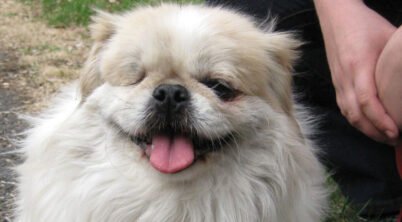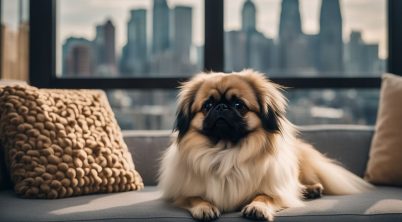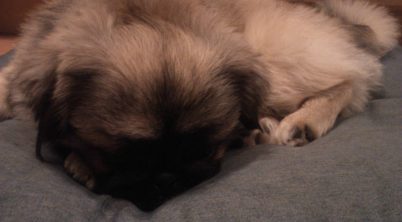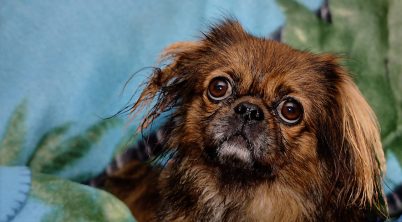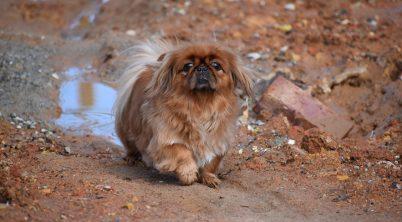The Pekingese is an ancient breed that traces its roots back to China, where it emerged as a favored companion of Chinese royalty. This small yet dignified toy dog is steeped in a rich history that aligns closely with the luxurious lives of the imperial families. Recognizable by its distinctive rolling gait and lion-like mane, the Pekingese has maintained its status as a symbol of regal elegance throughout the centuries.
Though Pekingese dogs are generally classified as a toy breed, they come in various sizes. Occasionally, individual Pekingese can surpass the typical size range for the breed, capturing attention as some of the largest specimens of their kind. Despite their more substantial stature, these larger Pekingese retain the breed’s characteristic traits, such as undying loyalty and affection for their human companions.
As a breed developed for companionship, the Pekingese displays an unwavering bond with its owners, echoing the breed’s historical role at the side of Chinese emperors and nobles. Their presence is a testament to the lasting legacy of the breed’s origins in ancient China, and these dogs continue to exude the dignity and poise that once graced the halls of the Forbidden City.
Table of Contents
Largest Pekingese
The Pekingese breed, with its roots in ancient China, is typically categorized as a toy dog due to its smaller size. Nevertheless, there exists variation in size even within this breed. The largest Pekingese recorded is an outlier when considering the breed’s standard dimensions, which generally set the weight range between 7 to 14 pounds.
Some factors that may contribute to a Pekingese’s size surpassing the breed standard include genetics and environmental aspects such as diet and overall health. These dogs retain their signature compact and stocky structure even when they are larger than average, with the same bold and lion-like demeanor known to the breed.
It is not common for the Pekingese to reach exceptional sizes, and breeders typically aim to conform to the breed standards. Larger individuals may demand special attention to their dietary and exercise needs to maintain an optimal weight and avoid health issues. Pekingese owners should be attentive to their pets’ specific needs given their distinctive body shape, ensuring they lead a healthy and comfortable life.
When it comes to the world records, stories of particularly large Pekingese may circulate within dog enthusiast circles or appear in exceptional case studies. However, these cases should be treated as rarities rather than typical representations of the breed.
Physical Characteristics
The Pekingese breed commands attention with its compact, muscular frame and a gait that sets it apart. These attributes are part of its appeal and genetics rooted in royal Chinese ancestry.
Appearance and Size
The Pekingese boasts a notably stocky and muscular build, resulting in a compact silhouette. In terms of size, they typically stand about 6-8 inches tall at the withers and possess a weight that can go up to 14 pounds. A defining trait of the Pekingese is its rolling gait, which reflects its dignity and unique skeletal structure.
- Height at withers: 6-8 inches
- Weight: Up to 14 pounds
Distinctive Features
The coat of a Pekingese is long, emphasizing its regal bearing, with common colors including tan, red, black, white, and cream. Their fur can be straight or slightly wavy, contributing to the “lion’s mane” appearance around the neck and shoulders. They possess a brachycephalic (flat-faced) muzzle, with a short snout that’s a breed hallmark. Another prominent feature is their large, expressive eyes, often described as being set in a “V-shaped facial wrinkle.”
- Coat Colors: tan, red, black, white, cream
- Fur Texture: Long, flowing; can be straight or wavy
- Face: Brachycephalic, with a short snout and prominent “V-shaped” wrinkle
Health and Care
Pekingese dogs are brachycephalic breeds, meaning they have broad, short skulls that give them a distinctive flat-faced appearance. This feature, however, predisposes them to certain health problems, such as breathing difficulties known as brachycephalic syndrome. It is crucial to monitor their respiratory health closely and avoid exposing them to extreme temperatures.
When it comes to nutrition, these dogs may be prone to obesity if overfed or under-exercised. A balanced diet and regular exercise can help manage their weight. Owners should strive for a diet that supports their metabolic needs and portion control to prevent overweight issues.
Grooming is another vital aspect of a Pekingese’s care routine. Their long, luxurious coat requires regular brushing to prevent shedding and matting. It is recommended to brush their fur several times a week and provide occasional trimming to maintain coat health and hygiene.
Special attention should be given to their eye issues due to their prominent eyes which can lead to complications. Careful monitoring for signs of irritation or infection can mitigate potential problems. Conditions like progressive retinal atrophy may also affect Pekingese, thus regular veterinary eye exams are advised.
Lastly, Pekingese can suffer from various orthopedic issues, including intervertebral disc disease. Owners should ensure a safe environment with limited jumping to reduce the risk of spinal injuries. Regular vet check-ups can help in early diagnosis and management of these conditions, promoting a better quality of life for these dignified companions.
Owner’s Guide
Owning the largest Pekingese comes with unique responsibilities, particularly in terms of exercise, training, and the environment you provide. Understanding these needs ensures that this royal breed leads a balanced and happy life within a family setting.
Exercise and Training
Pekingese may be part of the toy group, but they require consistent daily exercise to maintain their health. A short walk or a playful session each day is sufficient for their small stature. Families should be mindful that despite their size, Pekingese possess a playful nature and enjoy engaging activities.
Training this breed calls for positive reinforcement techniques. The Pekingese can display a sense of independence which might challenge trainability. Consistency is key, and integrating training sessions into the daily routine is recommended to foster obedience while respecting this breed’s dignity.
Socialization and Environment
As an American Kennel Club recognized breed, the Pekingese boasts a history of being both watchdogs and companions. Their vocal nature and alertness make them effective as watchdogs in a family environment. Socialization should start early to moderate their protective instincts, which, if unmanaged, can lead to excessive wariness around strangers.
Environmental consideration is central for a Pekingese’s contentment. They thrive in a secure and love-filled ambiance, away from harsh weather due to their thick sable coats – as recommended by the Pekingese Club of America. They are adaptable to living spaces but benefit from a consistent and calm environment.

